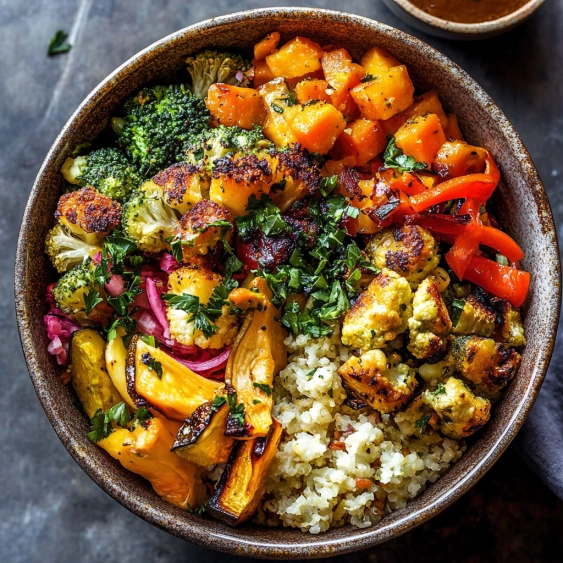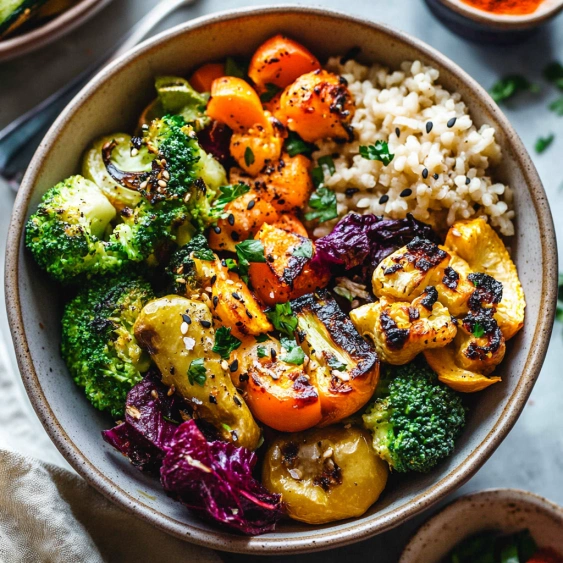 Pin it
Pin it
This vibrant and nourishing roasted veggie glow bowl has become my go-to meal when I need something that's both satisfying and packed with nutrients. The colorful combination of caramelized vegetables, protein-rich quinoa, and that golden tahini dressing creates the perfect balance of flavors and textures in every bite.
I first created these bowls during a particularly busy work week when I needed something nutritious that would keep me energized. Now they've become a weekly staple, and I love how versatile they are with seasonal produce.
Ingredients
- Cauliflower florets: Provide a hearty base that gets beautifully caramelized in the oven. Look for heads that feel heavy for their size with tight florets.
- Carrots: Bring natural sweetness when roasted. Choose firm carrots with vibrant color for the best flavor.
- Extra virgin olive oil: Helps vegetables caramelize and adds richness. Use a good quality oil for best results.
- Smoked paprika: Brings a subtle smokiness that transforms ordinary vegetables. Spanish varieties offer the most authentic flavor.
- Quinoa: Serves as the protein-packed base. Rinse it well before cooking to remove any bitterness.
- Fresh kale: Adds crucial nutrients and a pleasant texture. Massage it briefly if you find it too tough.
- Pumpkin seeds: Offer a wonderful crunch contrast. Toast them lightly to enhance their nutty flavor.
- Tahini: Creates the creamy base for our dressing. Look for one that's well-stirred and not bitter.
- Spices: Like turmeric and curry powder give the dressing its golden color and anti-inflammatory properties.
Step-by-Step Instructions
- Prepare the Vegetables:
- Toss cauliflower florets and carrots with olive oil and spices until thoroughly coated. Be generous with the oil to ensure proper caramelization and prevent sticking. Spread them evenly on your baking sheet, giving them enough space to roast rather than steam.
- Roast to Perfection:
- Place vegetables in your preheated oven for 25-30 minutes, turning halfway through. Look for deep golden edges and a fork-tender interior. The caramelization is crucial for developing rich flavor, so don't rush this step.
- Cook the Quinoa Base:
- Combine quinoa with vegetable broth in a saucepan and bring to a boil. Reduce heat immediately once boiling, then cover and simmer gently for exactly 15 minutes. Resist the urge to peek or stir during cooking for the fluffiest texture.
- Incorporate the Greens:
- Stir chopped kale and a tablespoon of olive oil directly into the hot quinoa. The residual heat wilts the kale perfectly without overcooking, preserving its nutrients and giving it a tender-crisp texture.
- Make the Golden Dressing:
- Whisk together tahini, vinegar, maple syrup, and spices until completely smooth. Add water gradually, one tablespoon at a time, until you reach a pourable consistency. The dressing should coat the back of a spoon but still flow easily.
- Assemble Your Masterpiece:
- Layer quinoa and kale mixture at the base of each bowl. Arrange roasted vegetables artfully on top, adding sliced avocado for creaminess. Drizzle generously with the golden tahini dressing and finish with pumpkin seeds and fresh parsley for color and texture.
 Pin it
Pin it
The curry powder in the dressing is my secret weapon in this recipe. My grandmother always used curry in unexpected ways, and this dressing reminds me of her experimental spirit in the kitchen. The warming spices transform simple tahini into something truly special that ties the whole bowl together.
Make-Ahead Storage
These bowls are perfect for meal prep. Store the roasted vegetables, quinoa kale mixture, and dressing separately in airtight containers in the refrigerator for up to 4 days. The vegetables and quinoa can be reheated gently in the microwave, while the dressing is best kept at room temperature for 20 minutes before serving to maintain its creamy consistency. Add fresh avocado only at the time of serving to prevent browning.
 Pin it
Pin it
Seasonal Variations
During summer, try substituting summer squash and cherry tomatoes for the carrots and roasting them for just 15-20 minutes. In fall, sweet potatoes and Brussels sprouts make an excellent alternative to the cauliflower. Winter calls for heartier options like roasted beets and parsnips which pair beautifully with the golden dressing. The beauty of these bowls is their adaptability to whatever is freshest and most affordable at the market.
Nutritional Powerhouse
These bowls deliver an impressive nutritional profile with each component offering specific benefits. The roasted vegetables provide fiber and vitamins A and C, while quinoa contributes complete protein, magnesium and B vitamins. Kale adds calcium and vitamin K, and the tahini dressing delivers healthy fats and calcium. The turmeric and black pepper combination has been studied for its potential anti-inflammatory effects, making this not just a delicious meal but a functional food that supports overall wellbeing.
Frequently Asked Questions
- → Can I meal prep these veggie bowls?
Absolutely! Roast the vegetables and cook the quinoa up to 3 days ahead. Store components separately in airtight containers. The dressing can be made 5 days in advance. When ready to eat, reheat the quinoa and vegetables, then assemble with fresh avocado and dressing.
- → What can I substitute for kale?
Spinach, Swiss chard, or arugula work well as alternatives. Spinach and arugula will wilt faster than kale, so add them right before serving. Swiss chard needs a similar wilting time to kale.
- → Is there a substitute for tahini in the dressing?
You can substitute almond butter, sunflower seed butter, or cashew butter. The flavor profile will change slightly, but they'll provide a similar creamy texture. Adjust the water as needed for consistency.
- → How can I make this dish more protein-rich?
Add roasted chickpeas, edamame, or tofu for plant-based options. For non-vegetarian versions, grilled chicken, salmon, or a soft-boiled egg would complement the flavors well.
- → Can I use different vegetables?
Definitely! Sweet potatoes, Brussels sprouts, bell peppers, and broccoli all roast beautifully with these spices. Maintain a similar total volume of vegetables and adjust roasting times as needed (denser vegetables may require longer cooking).
- → What can I use instead of quinoa?
Brown rice, farro, couscous, or bulgur wheat make excellent substitutes. Adjust cooking times and liquid according to package instructions for whichever grain you choose.
